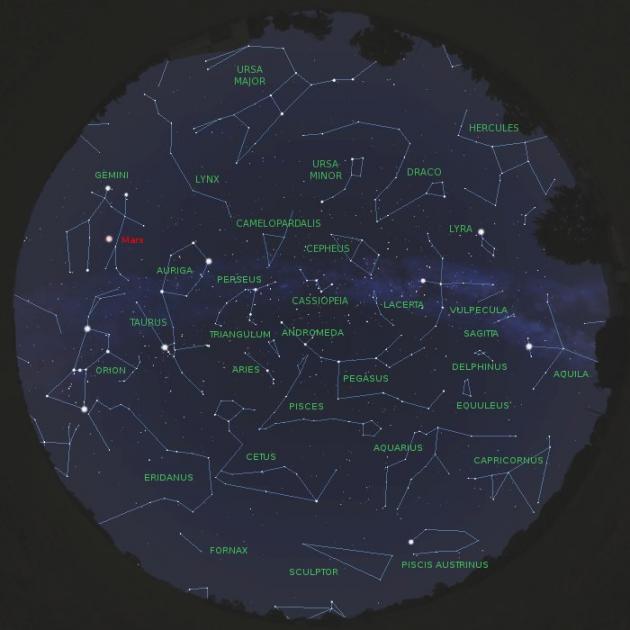- News / Thoughts
- Astronomy Guide
- On This Day
- Reviews
- Bookstore
Astronomical Events for November 2007
11/02/2007At the end of the last month, comet 17P/Holmes brightened almost million times, and instantly became new sky attraction for astronomers. How long will it stay visible is unknown, but try to find it as soon as you can.
This month you can only watch one planet in the evening, and that is Mars - the red planet. There is something else you can watch too: dwarf planet Ceres and two asteroids...
O

Evening sky for the middle of November 2007. at 09:00 PM. The map is valid for northern hemisphere, especially positions near 45 degrees latitude.
At the end of last month, comet 17P/Holmes suddenly brightened, from almost 18th magnitude, to 3rd, therefore becoming visible even to the naked eye. The difference of 15 magnitudes is equal to brightening of almost 1,000,000 (million) times!!! When viewed from Earth, it is located in the constellation of Perseus, and is easily recognized in binoculars as smudged star, you can even recognize comets tail. As of this time, it is not know how long it'll stay observable, but if you have clear skies at the beginning of this month, be sure to look for it. The location and what shape to look for can be found on the page of Sky & Telescope magazine.
Current position of this comet is about 2.5 AU (astronomical units) from the Sun, thereby it is entering asteroid belt area. Although we don't know what triggered sudden brightness, it is thought that the comet may have crashed into some smaller asteroid. 17P/Holmes is not in any way dangerous for planet Earth, since its orbit is between planets Mars and Jupiter.
While we are mentioning asteroids, this month we can observe a few of asteroid belt denizens, even in smaller telescopes, or even in binoculars. Dwarf planet Ceres will become as bright as 7.3 magnitude, as well as two asteroids: Flora (mag 8.0), and Amphitrite (mag 8.8). Positions of these objects are:
(1)Ceres
| Date | RA | Dec | Mag |
| 10/27 | 3h 19.7m | +8°24' | 7.5 |
| 11/06 | 3h 10.8m | +8°09' | 7.3 |
| 11/16 | 3h 01.4m | +8°00' | 7.3 |
| 11/26 | 2h 52.4m | +8°00' | 7.5 |
| 12/06 | 2h 44.8m | +8°11' | 7.7 |
(8) Flora
| Date | RA | Dec | Mag |
| 10/27 | 4h 05.5m | +9°59' | 8.4 |
| 11/06 | 3h 58.1m | +9°38' | 8.2 |
| 11/16 | 3h 48.3m | +9°26' | 8.0 |
| 11/26 | 3h 37.9m | +9°28' | 8.1 |
| 12/06 | 3h 28.6m | +9°48' | 8.3 |
(29) Amphitrite
| Date | RA | Dec | Mag |
| 10/27 | 3h 41.1m | +27°45' | 9.2 |
| 11/06 | 3h 31.9m | +27°49' | 8.9 |
| 11/16 | 3h 21.3m | +27°36' | 8.8 |
| 11/26 | 3h 10.8m | +27°09' | 8.9 |
| 12/06 | 3h 01.8m | +26°34' | 9.1 |
If you want to catch a planet, you can only try to find planet Mars, at least in the evening hours. Around 21:00 hours it is high enough for observing, and if you are able to use magnifications of 100x or higher you'll be able to spot color differences on it's disk, and maybe even detect its polar ice cap. More details than that is unfortunately hard to see with telescopes from Earth... we can only wave to Mars rovers, Discovery and Spirit, which even today, despite grim expectations, are working and sending data to scientists at NASA.
Also this month, at least for readers in USA, you have to be careful of the clock change. The rest of the world changed it's clock to standard (winter) time last month, and only USA is left to do it on first Sunday of this month, November 4, at 2. a.m. More info on this can be found at Global Time Zones web site.
Let us end this month review with Moon phases for November 2007:
- Last Quarter - November 1. 21:18 UT
- New Moon - November 9. 23:03 UT
- First Quarter - November Nov 17. 22:32 UT
- Full Moon - November 24. 14:30 UT